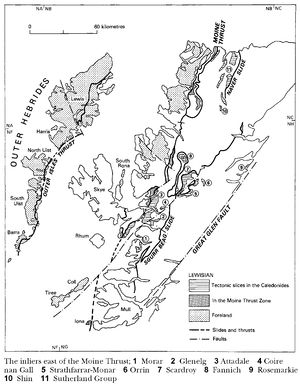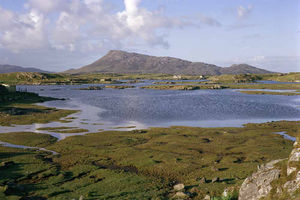Outer Isles Thrust Zone, Northern Highlands of Scotland
| Johnstone, G S and Mykura, W. 1989. British regional geology: Northern Highlands of Scotland. Fourth edition. Keyworth, Nottingham: British Geological Survey. |
Outer Isles Thrust Zone


Approximately parallel to the Moine Thrust Zone but about 85 km to the west lies the Outer Isles Thrust Zone (see P915460). This dips moderately ESE (P001011). The western margin of the thrust zone extends from Tolsta in northern Lewis to the Isle of Sandray, south of Barra, and it forms the eastern seaboard of North and South Uist and parts of South Harris. It is particularly well exposed in the Park district of Lewis, in South Uist and on the Isles of Eriskay and Barra. The eastern limit of the thrust zone lies beneath the waters of the Minch and in part probably terminates against the Minch Fault. In South Uist granulite-facies metadiorite (Corodale Gneiss) lies above the thrust, and in Barra some pyroxene- bearing acid gneisses also locally lie above the thrust. With these exceptions the thrust does not define a lithological boundary but lies within the heterogeneous Lewisian gneiss complex.
The major thrust plane is marked by a 1–10 m thick zone of pseudotachlite and cataclasite. Pseudotachylite is a black or dark grey, glassy material which develops as a result of frictional heating during ‘stick-slip’ faulting at moderate depths in the earth’s crust (see Sibson, 1975). The glass is generally devitrified, giving an extremely fine-grained rock with relict features of melting (e.g. microlites, intrusive veins, fine-grained margins). Cataclasite is a cohesive, nonfoliated, finely comminuted crush rock in which individual fragments are commonly microscopic (less than 1 mm) or even submicroscopic. In many areas this basal fault product is overlain by a thick pseudotachylite-gneiss breccia, notably in South Uist and Eriskay where up to 100 m are seen. Pseudotachylite is particularly abundant in the Outer Isles Thrust Zone and also occurs west of the thrust plane in either localised linear zones (e.g. in North Uist) or as wide diffuse zones in the gneiss (e.g. in Barra). Sparse examples also occur along the western seaboard of the Outer Isles.
The effects of subsequent lower greenschist-facies retrograde metamorphism and associated mylonite development are seen in parts of the thrust zone, particularly in North Uist and Lewis. Mylonite develops in narrow shear zones at moderate crustal depths and requires sufficient fluid to promote mineral reactions, recrystallisation and ductile deformation mechanisms, whereas pseudotachylite and cataclasite are dominantly products of brittle deformation in dry rock and are formed by melting and comminution respectively. The mylonite zones developed either subparallel to the relict gneissic banding, generally dipping moderately SE, or in zones dipping gently to moderately E, discordant to the gneissic banding. The age of the main pseudotachylite formation is thought to be late Laxfordian (Fettes and others, in press; but see Sibson, 1975) but the mylonite formation and related retrograde metamorphism are probably of Caledonian age. The pseudotachylite zones may correlate in age with the NW- to W-trending, subvertical pre-Torridonian crush zones found in Foreland Lewisian gneiss on the mainland of Scotland (e.g. Park, 1961).